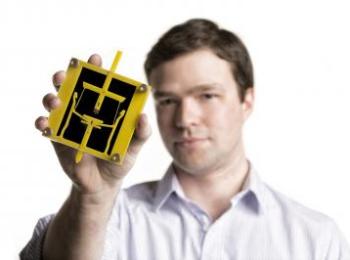Mar 6 2013
Nikolai Begg grew up in a box of LEGO® bricks and hasn't stopped tinkering since. Today he is an accomplished inventor with a portfolio of novel medical devices.
 Nikolai Begg received the prestigious 2013 $30,000 Lemelson-MIT Student Prize for his portfolio of novel medical devices which are helping to make surgical procedures less invasive, and therefore less risky. A Ph.D. candidate at MIT, Begg works directly with doctors and nurses in hospitals to better understand how his inventions can have a positive influence on medical procedures. Photo courtesy of the Lemelson-MIT Program
Nikolai Begg received the prestigious 2013 $30,000 Lemelson-MIT Student Prize for his portfolio of novel medical devices which are helping to make surgical procedures less invasive, and therefore less risky. A Ph.D. candidate at MIT, Begg works directly with doctors and nurses in hospitals to better understand how his inventions can have a positive influence on medical procedures. Photo courtesy of the Lemelson-MIT Program
Begg is the recipient of the prestigious $30,000 Lemelson-MIT Student Prize for his inventions that are making surgical procedures less invasive. He is honored alongside the 2013 $30,000 Lemelson-MIT Collegiate Student Prize winners from the University of Illinois at Urbana-Champaign and Rensselaer Polytechnic Institute.
Begg, a PhD candidate in the department of Mechanical Engineering at the Massachusetts Institute of Technology (MIT), first became interested in medical device engineering during junior high school after studying surgical robots and realizing their profound impact on human health. Today he works with doctors and nurses across medical disciplines in hospitals throughout Boston, to better understand how he can have a positive influence on medicine.
"Nikolai has a true appreciation for the importance of living a problem," said Alexander Slocum, Begg's advisor and Pappalardo Professor of Mechanical Engineering at MIT. "In a field where the end user is often difficult to reach, Nikolai is frequently invited into operating rooms after exciting a passion in physicians who can see that he is motivated only by the opportunity to create something that will transform the way they work."
A New "Gold-Standard" of Safety in Surgical Procedures
Epidurals, intravenous catheter placements and bone marrow biopsies are all examples of "puncture access procedures" in which a sharply-pointed instrument, the puncture device, is used to create a pathway into the patient's body. Despite puncture access being the first step in many minimally-invasive procedures like laparoscopic surgeries, existing devices often plunge forward after breaking through tissue until the surgeon can react and stop applying force, posing a risk to any underlying organs.
Begg invented a puncture access mechanism with a blade that retracts at the moment it passes completely through skin tissue after years of observing laparoscopic surgeries first-hand. A "force-sensing" instrument, the tip withdraws within 1/100 of a second. The mechanism, which is purely mechanical in nature with only a few parts, is scalable for use in nearly any medical puncture device.
Begg also learned that in right kidney laparoscopic procedures, an additional incision has to be made to hold the liver and clear a direct pathway to the kidney. This additional step risks over-puncture, infection and pain. He developed an incision-less laparoscopic retractor to address this challenge. Inserted through an existing incision, a suture stored within the device is passed out of the body and tensioned to move the organ out of the operating field.
An Ambassador for Invention
Begg's personal passion for invention is no more important than working to inspire the same in others. He has used his knack for explaining complex technologies to be an active mentor throughout his time at MIT. As a graduate instructor Begg helps undergraduate students design, prototype and refine novel devices to meet the needs of medical practitioners. He also worked with high school students at an MIT-sponsored summer course in design to invent and build functional prototypes of devices to introduce exercise into the workplace.
"I believe in showing others that invention does not mean being smart enough to get it right the first time," Begg said. "Creativity is powered by a willingness to learn and take risks."
Bringing a New Face to Invention
"Nikolai Begg exemplifies the modern inventor," said Joshua Schuler, executive director of the Lemelson-MIT Program. "Far from the image of a white-coat scientist at the lab bench, he follows his innate interests, immersing himself in them and collaborating with others to uncover opportunities to invent in every experience. By giving a fresh face to invention he is inspiring others– including those who may not have ever imagined or believed themselves to be inventors before."
The Lemelson-MIT Program also recognized the 2013 Lemelson-MIT Student Prize finalists:
- Benjamin Peters developed a pin bed mechanism for directly forming physical three-dimensional contoured surfaces from a digital file.
- Ahmed Kirmani invented compact, low power cameras that capture the world in three-dimensions, which could usher new forms of human-machine interaction, automation and medical imaging.
Lemelson-MIT Collegiate Student Prizes
Winners of the $30,000 Lemelson-MIT Collegiate Student Prize will also be announced at their respective universities:
- Lemelson-Illinois Student Prize: Eduardo Torrealba launched the Plant Link platform in 2013, which monitors the moisture needs of plants and delivers water on an as-needed basis using smart valves, interconnected sensor systems and mobile devices. This wireless platform will make agricultural water resource management easier and more affordable, impacting the sustainability of water usage on a global scale.
- Lemelson-Rensselaer Student Prize: Ming Ma has developed a new method to manufacture light-emitting diodes (LEDs) that are brighter, more energy efficient, and have superior technical properties than those on the market today. His innovation holds the promise of hastening the widespread adoption of LEDs and reducing the overall cost, energy consumption, and environmental impact of illuminating our homes and businesses.